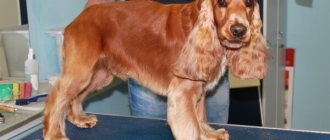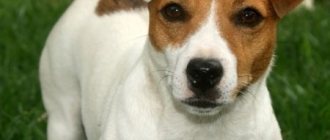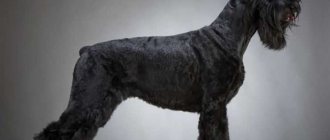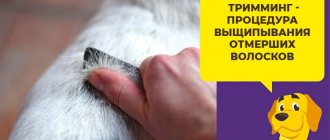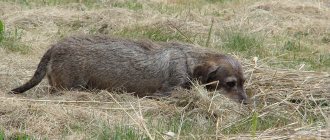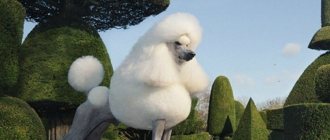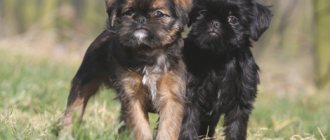Owners of animals with long hair are rightfully proud of their pets. Their luxurious hair allows them to experiment when cutting their hair, but the owners of such dogs also have more problems with care than others. It is for this reason that they most often turn to the Little Emperor grooming salon, entrusting part of the work on caring for their pet to professionals. A haircut performed by our highly qualified professionals will give your dog a well-groomed appearance, and other procedures will help improve its health.
Why grooming is so important
Long-haired breeds shed significantly less than their short-haired counterparts. But if the coat is not cleaned in a timely manner and excess is not removed, then the formation of tangles is guaranteed. This can lead to skin inflammation. In addition to the hygienic purpose, grooming also has an aesthetic significance, as it allows you to evenly distribute the guard hairs, giving the desired image.
To keep your pet looking beautiful, you need to visit a groomer at least once a month. But in addition to a beautiful hairstyle, other hygiene procedures are also needed, such as:
- care for the face, paws, groin and anal areas;
- nail cutting;
- cleaning the ears;
- washing and drying wool.
Performing grooming requires precise knowledge of the rules of cutting, in accordance with the standards and specifics of the breed. Therefore, in order to properly prepare your pet for participation in an exhibition, it is better to entrust hair care to the stylists from the Little Emperor salon, who are capable of performing any type of haircut with high quality and at a high professional level.
Irish Terrier
The method of preparing the Irish Terrier's coat for an exhibition is as follows.
Depending on your dog's hair growth rate, when stripping, pull hair almost all the way to the skin, with the exception of beard hair, eyebrow hair, and leg hair. This should be done approximately 11-12 weeks before the dog is expected to participate in the exhibition. Depending on the rate of hair regrowth in your individual dog, strip the undercoat approximately four to five weeks after stripping the outer coat. Two to three weeks before the show, strip the hair on the ears, head and neck again, making sure that the hair in these areas blends smoothly into the longer hair on the body.
Much attention should also be paid to such details as the general expression of the “face,” paws and claws, decorative fur, teeth and ears. In addition, you also need to remove some stray hairs on the belly, on the inside of the hind legs and around the base of the tail.
To achieve the desired expression, great care must be taken when trimming the head. The hair on the head should be kept short, but on the muzzle longer decorative hair may be left to add extra volume to the front of the muzzle. The beard towards the front end of the jaw should be left long enough to make the head appear elongated. However, the head should not be so long that the overall appearance of the dog becomes unbalanced.
The fur on the cheeks and throat should be trimmed very short to give the head and neck a clean, neat appearance. Cheek hair grows very quickly and should not be allowed to grow out of control.
The decorative coat becomes lighter and softer if dead hair is not removed regularly. Daily brushing of the whiskers and leg hair with a comb is usually sufficient to keep them in good condition. The Irish Terrier's coat should be brushed daily to keep the coat clean and lubricated with the natural lubricants normally found in the dog's coat and skin. For this purpose, use a natural bristle brush or a bristle mitten. Always brush the coat in the direction the hair lies, never in the opposite direction. For very coarse coats, it is also recommended to apply baby lubricant to the brush or mitten before combing, but this can be done no later than two weeks before the upcoming exhibition.
Grooming and conditioning of the coat should be done daily; only this regimen can lead to good results.
Grooming
Trimmed animals always look impressive and attractive. Luxurious hair significantly expands the possibilities for giving them a new look, even taking into account the exterior of the breed. Each new haircut can change your pet beyond recognition.
But having long hair also has some disadvantages - it needs constant combing and shortening. Only attentive attitude towards the dog on the part of the owner will allow it to look good. Another important factor is regular visits to the Little Emperor salon. Our experts are well versed in all the intricacies of trimming and know all the requirements for preparing for an exhibition.
For dogs with long hair, there are three basic types of haircuts:
- hygienic;
- model;
- for the exhibition.
Each of them is designed for specific purposes. A hygienic haircut allows you to keep the coat clean and is necessary for the health of your pets. Model - in addition to practical, it also has an aesthetic purpose. An experienced hairdresser at our salon will be able to create a hairstyle that will favorably highlight all the advantages of your four-legged friend and reliably hide any flaws, if any.
The most difficult haircut is the exhibition one. It is done immediately before participation and requires from the specialist, in addition to experience, also a share of creativity in order to advantageously emphasize all the anatomical features of the breed and point out the personal merits of the dog.
Do you want your pet to look amazing in any situation? Contact the professionals working in the Little Emperor salon. Our experts easily find an approach to the most capricious animals and perform all procedures without anesthesia. While professionals are working on the hairstyle for your four-legged friend, you can get free advice on care and maintenance, select the necessary accessories, hygiene products and food. We value every client, so a stay in our salon will be comfortable and enjoyable for both animals and their owners!
Price for cutting and trimming an Irish Terrier in Moscow
If you call a groomer to your home, the cost of his services will be several times cheaper than in a specialized salon. This is why most pet owners turn to mobile groomers, preferring to groom their dog at home.
As a rule, for Irish Terriers, rolling or stripping is more often ordered than clipping. The process of plucking old fur is a painstaking, time-consuming process that requires experience and high-quality tools; in a grooming salon, the cost of trimming a terrier is quite high. And since the guard hairs of wire-haired dogs need to be plucked regularly, a visit to the salon is expensive for many.
You can carry out the procedure at home; to carry out the procedure, it is not at all necessary to go to an animal hairdresser. You can invite a mobile groomer; there are a lot of such specialists in Moscow, and then caring for an Irish terrier will be cheap.
Keeping and caring for an adult dog
We have already mentioned that the Irish feel good in a loving family, both in an apartment and in a house. With sufficient walking and a variety of toys, the dog will behave well and will not chew furniture.
If you plan to keep your dog on a chain, the Irishman is not for you. This is an active and freedom-loving dog. If you keep him in an enclosure, be sure to walk your pet on a leash and communicate.
The Irish tolerate both heat and cold well, but you should not leave your pet outside for a long time in bad weather. Try to walk an adult dog at least 1.5 or 2 hours a day and at least 3 times a day.
Irish Wheaten Terriers are picky eaters, but when feeding, try to follow the recommendations:
- Give your terrier unsalted and fat-free food;
- The best basic food is fresh meat. This is veal or beef, with poultry;
- Cook fish for your pet 1-2 times every 7 days. Remove large bones or buy fillets straight away. Minced sprat or herring is also good;
- Vegetables, fruits and greens contain a lot of vitamins. Introduce them into your diet;
- Soups are of little benefit to your pet. Better give some porridge;
- When feeding dry food, change the water every 1-3 days.
2-3 times a year the pet undergoes hair trimming. Buy scissors with rounded tips and use them to cut out the fur between your pet's toes. The dog practically does not shed and does not smell like a dog. Bathe him as needed.
If you brush your dog’s teeth with a special toothbrush and meat-flavored toothpaste, you will preserve the dog’s teeth until old age. Check your pet's eyes regularly. If you notice dark discharge from them, this is a sign of disease. Contact your veterinarian. Trim overgrown claws promptly.
How does the process work?
There comes a time when it becomes necessary to trim the dog. As the fur grows, it becomes thin and brittle. This usually happens every six months. So, if you want your pet to look good and not freeze in winter, you need to trim your dog at least twice a year.
A healthy dog has dense hair that does not separate into strands. It should not look disheveled, but rather shiny. But over time, the cover loses its luster, fades, and becomes thinner. This is a sure signal that it is time to trim your pet.
For schnauzers and various terriers, the procedure is done twice a year, starting at 4 months. In some cases, they trim every season. Purebred dogs are trimmed from the age of 6 months during seasonal shedding.
In preparation for the competition, trimming is done 6-8 weeks before the exhibition.
If the hair is not growing at a very fast pace, the manipulation is carried out within 10-12 weeks. The procedure is carried out from head to tail.
- First, the back of the head is trimmed, then the sides of the neck, and then the top.
- The sides are processed from top to bottom, followed by the back.
- The hocks are the area up to which the thighs are treated.
- The shoulder blades are trimmed up to the elbow joints.
- The tail is processed from top to bottom.
Your pet may become distressed by the sound of the trimmer. In order for the dog to calm down, the procedure can be paused and continued later.
Trimming procedure:
- Disinfect the instrument.
- We place the dog on an elevated place where the procedure will be carried out.
- We comb the animal according to the growth of its fur, unraveling the fur and removing tangles.
- Using a knife, we begin trimming. First the back, then in the above order.
- We separate small tufts of hair, hold the area of skin surrounding it, and sharply pull it towards ourselves.
- We process the ears, sides, tail and limbs in random order, following our recommendations.
- When treating the head, you should first comb the dog. It is better to do the procedure on the head with your hands, constantly combing the dog and assessing its appearance.
- Treat the ears by removing hair with a machine.
- At the end of the procedure, comb and bathe your pet.
- Dry the animal's fur well, then use your hands to remove any stray hairs that you missed earlier.
That's all! You can be congratulated on your first trimming. If everything is done correctly, your pet will not only be pleasing to the eye, but will also become the object of your pride!
Required tools and materials
If you are planning to contact a specialist or a salon for trimming, there will be no need for your tools and consumables.
But if you decide to try yourself as a groomer, you will need:
- Trimming knife.
- Comb.
- Scissors.
- Hair clipper.
- Finger pads or rubber gloves.
- Talc powder.
You can take a ready-made knife, or you can make it yourself.
A slightly sharpened knife or a piece of a hacksaw equipped with something like a handle will do. If you do not have enough experience, you should not use sharp scissors at first. It is better to take a thick comb made of metal. In general, it is worth saying that the quality of the dog trimming tool is extremely important.
Trimming done with a good tool is not much different in quality from completely manual trimming.
Hair plucking
During the procedure, scissors are used only for hygienic cutting. Everything else is done with hands and a knife. There are very few craftsmen who do everything in full accordance with the rules, and their services are very expensive.
Manual plucking of dead fur, without the use of any tools, is considered a manifestation of the highest skill of the groomer.
This is a very labor-intensive and lengthy process. Its advantages compared to the traditional procedure using a knife:
- The wool does not break.
- This trimming is better tolerated by the animal itself.
Most groomers use tools, often only really trimming the back. They may even offer a machine haircut.


